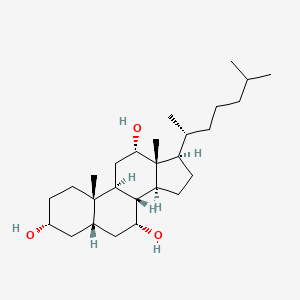| Authors | Title | Published | Journal | PubMed Link |
|---|---|---|---|---|
| Une M et al. | Comparative studies on omega-hydroxylation of 5 beta-cholestane-3 alpha, 7 alpha, 12 alpha-triol in the mitochondrial and microsomal fraction of the liver from several vertebrates. | 1997 | Steroids | pmid:9185292 |
| Fricker G et al. | Enterohepatic circulation of scymnol sulfate in an elasmobranch, the little skate (Raja erinacea). | 1997 | Am. J. Physiol. | pmid:9374698 |
| Betsholtz IH and Wikvall K | Cytochrome P450 CYP27-catalyzed oxidation of C27-steroid into C27-acid. | 1995 | J. Steroid Biochem. Mol. Biol. | pmid:7577714 |
| Ikegawa S et al. | Stereoisomeric inversion of (25R)- and (25S)-3 alpha,7 alpha,12 alpha-trihydroxy-5 beta-cholestanoic acids in rat liver peroxisome. | 1995 | Biol. Pharm. Bull. | pmid:7581245 |
| Dahlbäck H and Holmberg I | Oxidation of 5 beta-cholestane-3 alpha,7 alpha, 12 alpha-triol into 3 alpha,7 alpha,12 alpha-trihydroxy-5 beta-cholestanoic acid by cytochrome P-450(26) from rabbit liver mitochondria. | 1990 | Biochem. Biophys. Res. Commun. | pmid:2322231 |
| Saarem K and Pedersen JI | Effect of age, gonadectomy and hypophysectomy on mitochondrial hydroxylation of vitamin D3 (cholecalciferol) and of 5 beta-cholestane-3 alpha,7 alpha,12 alpha-triol in female and male rat liver. | 1988 | Biochem. J. | pmid:2840896 |
| Saarem K and Pedersen JI | Sex differences in the hydroxylation of cholecalciferol and of 5 beta-cholestane-3 alpha, 7 alpha, 12 alpha-triol in rat liver. | 1987 | Biochem. J. | pmid:2825658 |
| Skrede S et al. | Demonstration of 26-hydroxylation of C27-steroids in human skin fibroblasts, and a deficiency of this activity in cerebrotendinous xanthomatosis. | 1986 | J. Clin. Invest. | pmid:3745434 |
| Lidström-Olsson B and Wikvall K | The role of sterol carrier protein2 and other hepatic lipid-binding proteins in bile-acid biosynthesis. | 1986 | Biochem. J. | pmid:3800967 |
| Shimazu K et al. | Bile alcohol profiles in bile, urine, and feces of a patient with cerebrotendinous xanthomatosis. | 1986 | J. Biochem. | pmid:3700361 |
Trihydroxycoprostane
Trihydroxycoprostane is a lipid of Sterol Lipids (ST) class. The involved functions are known as Uptake, Enterohepatic Circulation, Metabolic Inhibition and Ionization. Trihydroxycoprostane often locates in Hepatic, Entire gastrointestinal tract and Abdominal Cavity. The related lipids are 3,7,12-trihydroxycoprostane, (3beta,5beta,7alpha,12alpha)-isomer, Cholestanes and scymnol.
Cross Reference
Introduction
To understand associated biological information of Trihydroxycoprostane, we collected biological information of abnormalities, associated pathways, cellular/molecular locations, biological functions, related genes/proteins, lipids and common seen animal/experimental models with organized paragraphs from literatures.
What diseases are associated with Trihydroxycoprostane?
There are no associated biomedical information in the current reference collection.
No disease MeSH terms mapped to the current reference collection.
PubChem Associated disorders and diseases
What pathways are associated with Trihydroxycoprostane
There are no associated biomedical information in the current reference collection.
PubChem Biomolecular Interactions and Pathways
Link to PubChem Biomolecular Interactions and PathwaysWhat cellular locations are associated with Trihydroxycoprostane?
Visualization in cellular structure
Associated locations are in red color. Not associated locations are in black.
Related references are published most in these journals:
| Location | Cross reference | Weighted score | Related literatures |
|---|
What functions are associated with Trihydroxycoprostane?
Related references are published most in these journals:
| Function | Cross reference | Weighted score | Related literatures |
|---|
What lipids are associated with Trihydroxycoprostane?
Related references are published most in these journals:
| Lipid concept | Cross reference | Weighted score | Related literatures |
|---|
What genes are associated with Trihydroxycoprostane?
There are no associated biomedical information in the current reference collection.
What common seen animal models are associated with Trihydroxycoprostane?
There are no associated biomedical information in the current reference collection.
